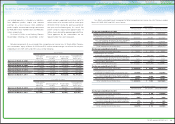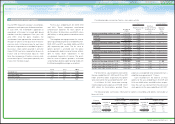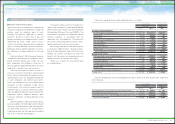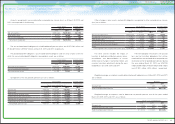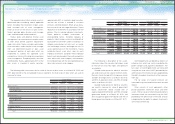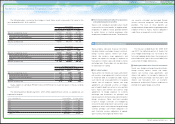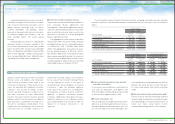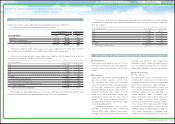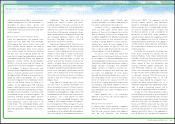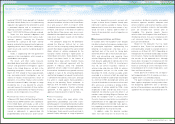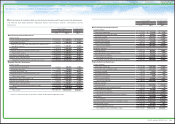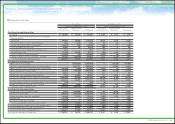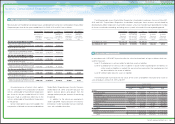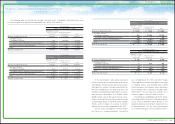Toyota 2011 Annual Report Download - page 100
Download and view the complete annual report
Please find page 100 of the 2011 Toyota annual report below. You can navigate through the pages in the report by either clicking on the pages listed below, or by using the keyword search tool below to find specific information within the annual report.
0822
Financial Section and
Investor Information
Business and
Performance Review
Special FeatureMessage/Vision
Management and
Corporate Information
Notes to Consolidated Financial Statements
resolving TQ10-002, Toyota denied that it violated
the Motor Vehicle Safety Act or its implementing
regulations but agreed to the settlement to avoid
a protracted dispute and to concentrate on
regaining customer confidence. In addition, on
March 1, 2011, RQ10-003 was officially resolved.
Toyota has also received subpoenas and
formal and informal requests from various states’
attorneys general, including the Executive
Committee for a group of 28 states’ attorney
general, and certain local governmental agencies
regarding various recalls, the facts underlying its
recent recalls and customer handling related to
those recalls.
Toyota is cooperating with the government
agencies in their investigations, which, except as
noted above, are on-going.
The recalls and other safety measures
described above have led to a number of claims,
lawsuits and government investigations against
Toyota in the United States as set forth in the
preceding paragraphs. Amounts accrued as of
March 31, 2011 related to these legal proceed-
ings and governmental investigations are not
material to Toyota’s financial position, results of
operations, or cash flow. Toyota cannot currently
estimate its potential liability, damages or range
of potential loss, if any, beyond the amounts
accrued; however, the resolution of these matters
could have an adverse effect on Toyota’s financial
position, results of operations or cash flows.
In February 2003, Toyota, GM, Ford, DaimlerChrysler,
Honda, Nissan, BMW and their sales subsidiaries
in the United States and Canada, as well as the
National Automobile Dealers Association and the
Canadian Automobile Dealers Association were
named as defendants in approximately 85
purported federal and state class action lawsuits
loss, if any, beyond the amounts accrued, with
respect to these claims. However, based upon
information currently available to Toyota, Toyota
believes that its losses from these matters, if any,
would not have a material adverse effect on
Toyota’s financial position, results of operations or
cash flows.
In October 2000, the European Union brought
into effect a directive that requires member states
to promulgate regulations implementing the
following: (i) manufacturers shall bear all or a
significant part of the costs for taking back
end-of-life vehicles put on the market after July 1,
2002 and dismantling and recycling those
vehicles. Beginning January 1, 2007, this require-
ment became applicable to vehicles put on the
market before July 1, 2002; (ii) manufacturers
may not use certain hazardous materials in
vehicles to be sold after July 2003; (iii) vehicles
type-approved and put on the market after
December 15, 2008, shall be re-usable and/or
recyclable to a minimum of 85% by weight per
vehicle and shall be re-usable and/or recoverable
to a minimum of 95% by weight per vehicle; and
(iv) end-of-life vehicles must meet actual re-use of
80% and re-use as material or energy of 85%,
respectively, of vehicle weight by 2006, rising
respectively to 85% and 95% by 2015. A law to
implement the directive came into effect in all
member states including Bulgaria, Romania that
joined the European Union in January 2007.
Currently, there are uncertainties surrounding the
implementation of the applicable regulations in
different European Union member states, particu-
larly regarding manufacturer responsibilities and
resultant expenses that may be incurred.
In addition, under this directive member
states must take measures to ensure that car
on behalf of all purchasers of new motor vehicles
who purchased their vehicles in the United States
on or after January 1, 2001. As of April 1, 2005,
the federal lawsuits were consolidated in the State
of Maine, and lawsuits in the State of California
and the State of New Jersey were also consoli-
dated within the respective states. Lawsuits in the
state courts have been stayed until the federal
lawsuits proceed.
The complaints allege that the defendants
violated the Sherman Antitrust Act or state
anti-trust law by conspiring among themselves
and with their dealers to prevent the sale to United
States citizens of vehicles produced for the
Canadian market, resulting in higher prices to
United States consumers. Toyota believes that its
actions have been lawful. In the interest of
resolving these legal actions, however, Toyota
entered into a settlement agreement with the
plaintiffs in February 2006. The settlement
agreement remains subject to court approval. In
the meantime, the federal court granted summary
judgment in favor of the remaining defendants
and the time to appeal has lapsed. Current activity
is centered in the California state courts, although
that action is stayed against Toyota pending a
ruling on the pending Toyota settlement. In
February 2011, the federal court held a hearing
with respect to approval of Toyota’s settlement
agreement. If final approval is granted, that
approval should resolve this matter for Toyota.
Toyota has various other legal actions, other
governmental proceedings and other claims
pending against it, including other product liability
claims in the United States. Although the claimants
in some of these actions seek potentially substan-
tial damages, Toyota cannot currently estimate its
potential liability, damages or range of potential
manufacturers, distributors and other auto-related
economic operators establish adequate used
vehicle collection and treatment facilities and to
ensure that hazardous materials and recyclable
parts are removed from vehicles prior to
shredding. This directive impacts Toyota’s
vehicles sold in the European Union and Toyota is
introducing vehicles that are in compliance with
such measures taken by the member states
pursuant to the directive.
Based on the legislation that has been
enacted to date, Toyota has provided for its
estimated liability related to covered vehicles in
existence as of March 31, 2011. Depending on
the legislation that will be enacted subject to other
circumstances, Toyota may be required to revise
the accruals for the expected costs. Although
Toyota does not expect its compliance with the
directive to result in significant cash expenditures,
Toyota is continuing to assess the impact of this
future legislation on its results of operations, cash
flows and financial position.
Toyota purchases materials that are equiva-
lent to approximately 10% of material costs from a
supplier which is an affiliated company.
The parent company has a concentration of
labor supply in employees working under collec-
tive bargaining agreements and a substantial
portion of these employees are working under the
agreement that will expire on December 31, 2011.
United States Antitrust Proceedings Other Proceedings
Environmental Matters and Others
100TOYOTA ANNUAL REPORT 2011


